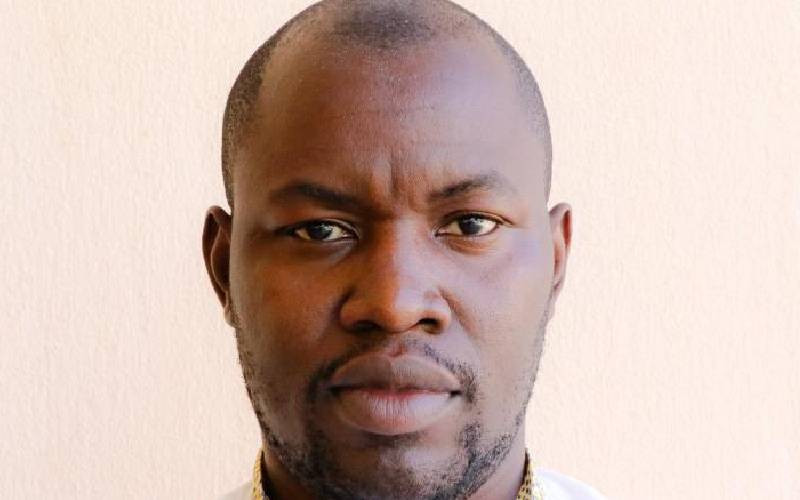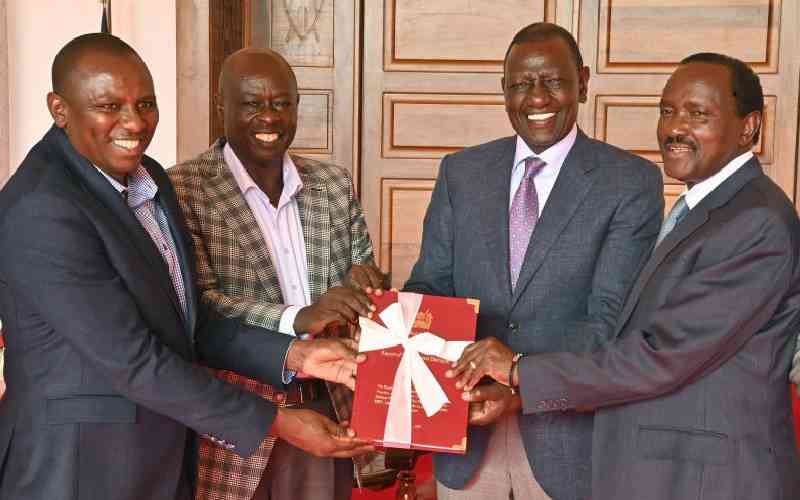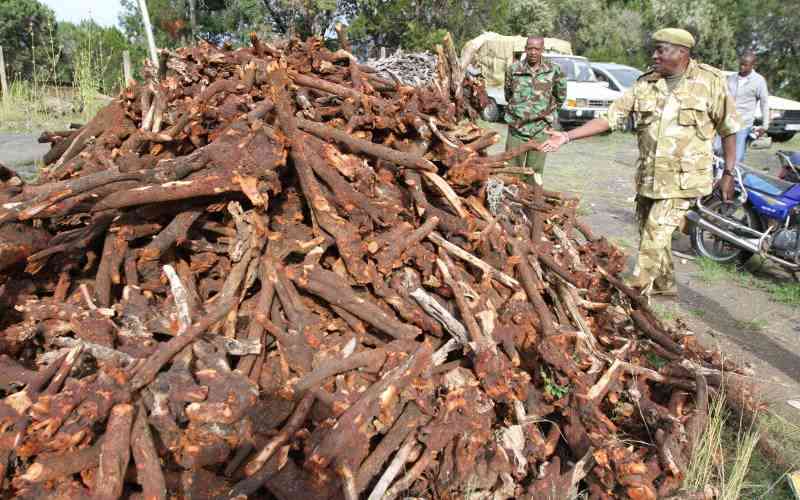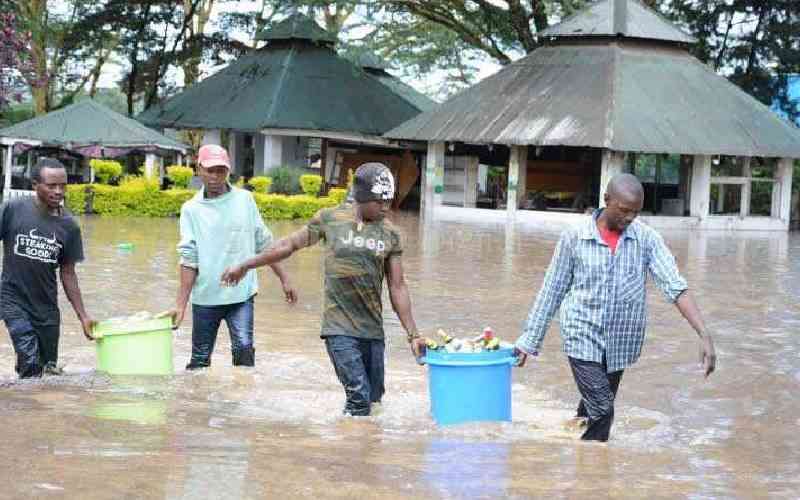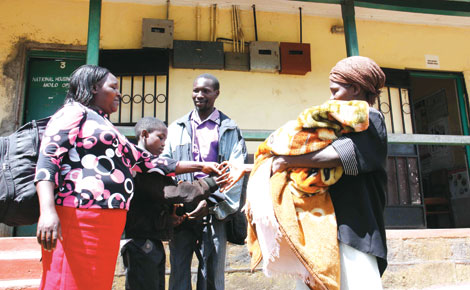 |
|
Ruth Wambui (left), a good samaritan who was living with John Mwangi (second left) hands him over to his biological parents Peter Njuguna and Penninah Wanjiku in Molo, Nakuru County. |
Nairobi, Kenya: On July 14 last year, newspapers carried a two-page advert with pictures of children and boldly headlined, ‘Are you my family? These children ask!’
It was a Sunday. Mark Likoye, a mechanic, got a call from a friend. “Check the papers, there is something that concerns you.”
Mr Likoye recalls vividly how on January 9, he returned to his Shauri Moyo home in Nairobi at 7pm to be told his seven-year-old daughter, Maureen Akwabi, had gone missing from 1pm. A seven-month nightmare then began.
“She had gone to the shop with her older sister, and somewhere along Jogoo Road, the sister asked her to cross the road and buy bananas. A trailer passed by and after it was gone, the girl was nowhere to be seen.”
That night, Likoye checked in all the police stations on any reports of his missing daughter in vain.
“At Buru Buru Police Station, I found two policemen who said three children had been booked in as missing that night. They, however, debated who would go unlock the door where they were being held for me to identify them, before they asked me to leave and come the following day.”
He never got to identify the children and two days later, Margaret Kwamboka, the Tracing and Integration Officer at the Child Welfare Society of Kenya (CWSK) says they received a call from the Buru Buru Police Station. They received a seven year-old girl who was later identified as Maureen Akwabi, and took her to Mama Ngina Children’s Home.
The adverts were already yielding results.
The society, in line with World Conventions on the Right of the Children, believe that no child should grow up in an institution. The Hague Convention on Protection of Children and Co-operation in Respect of Inter-country Adoption stipulates that each State, as a matter of priority, should put appropriate measures to enable the child remain in the care of his or her family of origin.
So many children are getting lost; reuniting and reintegrating them with their families is a great headache. Thus in July last year, the society devised a clever way to trace the families by publicly appealing through the newspaper adverts.
Identify
Before the advertisements were placed in the dailies, Likoye struggled to find his missing daughter. He visited media houses, printed a poster, which he took to Namanga after he was told it was a child trafficking panya route, but no luck. Some police officers told his pregnant wife, Esther Aura, to take it easy, “as she was lucky another child was on the way.”
And, three days after Aura gave birth, the newspaper advertisement with a picture of their missing daughter ended the couple’s agony.
“With my fingers trembling, I needed help to identify my daughter,” says Likoye. There were 140 children on the advertisement and at the bottom was Maureen.
He called CWSK and was informed there was a due process to be followed before a prospective family is reunited with their child.
“We have to ascertain that indeed they are the real parents. For Maureen’s case, we took a picture and she identified her parents. We also did a home visit, and our assessment was that they were the real family,” says Kwamboka.
Later that week, the family reunited at the Lang’ata Children’s Office. “It was an emotional time for all of us,” says the soft spoken Likoye.
Stay informed. Subscribe to our newsletter
Other 20 children have also been reunited with their families.
Many lost children do not even know their names. This lack of one’s bio-data is the biggest bane to police officers and social workers seeking to reunite them with their parents.
And the numbers are mind-boggling. Every month, the CWSK rescues about 30 to 40 children, either abandoned by their parents, guardians, or lost after accidents and disasters.
These children end up in Charitable Children’s Institutions (CCIs) popularly known as homes, and some on the streets. In 2009, Unicef estimated that there are about 200,000 children scattered in about 1,200 CCI’s.
One case from the newspaper adverts is particularly heart rending — that of Victoria Lubanga, a victim of family disintegration, according to Irene Mureithi, the Executive Director, CWSK.
Nine year-old Victoria has her lower legs amputated. She walks in prosthesis and lives in Maji Mazuri, Kasarani with her uncle, Richard Aswani, a father of four.
Aswani says that when Victoria was three years, her parents separated. She left with her mother to the maternal grandmother’s home in Khwisero, Kakamega. Soon after, Victoria’s father ‘stole’ her. The family did not report the case to the police.
“They came to Nairobi and we later heard that Victoria had fallen ill. She was taken to Kenyatta National Hospital (KNH) and her father warned us against looking for her,” says Aswani. “We heard rumours that Victoria was later abandoned at KNH. We tried tracing her, but we were not successful.”
It was after five years that Aswani saw his niece’s picture in a newspaper advertisement listed as a missing child.
Kwamboka the CWSK officer says they rescued Victoria from KNH on December 17, 2009, and placed her at Mama Ngina Children’s Home and later to Karen A Foster Home. She had been diagnosed with bilateral gangrene, which led to the amputation of her lower limbs.
End up in the streets
“According to a placement letter from the provincial children’s office acquired from KNH, the mother of the child is listed as deceased. However, Aswani’s sister, Agnes Adhiambo and Victoria’s mother are alive. We performed a DNA test and it turned positive,” says Kwamboka. Adhiambo has since remarried and it was decided the child should stay with the uncle. She studies at the Strong Towers Academy in Kasarani.
“As you can see, many cases of the children ending in the streets with a risk of abuse and trafficking is due to family disintegration and poverty,” says Irene Mureithi, adding that families need support like in the Western countries. Indeed, in most of the cases we reviewed, the parents who have lost their children are of limited education, casual labourers and do not have much time for their children.
“Our families are receiving a beating. I also think that men are under-pressure and not appreciated enough. They abandon their families when the heat of responsibility becomes unbearable,” she says.
Irene’s sentiment is echoed by Mali Nilsson a senior adviser with Child Protection Save the Children-Sweden. In an International perspective meeting on Institutional Care and Adoption: Policy, Laws and Regulation held in November 2011 in Nairobi, Nilsson gave a moving presentation about the rights of the child.
She said the assumption that the thousands of children who live in children’s homes are orphans is a mere “myth”.
“Most are there because their parents simply can’t afford to feed, clothe and educate them. For governments and donors, placing children in institutions is often seen as the most straightforward solution. And it’s a way of sweeping out of sight the poorest and most discriminated against children with the most problems,” she says.
The role of poverty in cases of missing children was evident in Molo, where we meet John Mwangi, who got lost after his mother turned to the bottle. The father, a farm casual labourer fled the home (see separate story).
And in Ngei 1, Huruma Estate, Nairobi, two-year-old, Ebrahim Gitau greets us at his grandmother’s house. His 24-year-old father, John Gichuri says the baby had been abandoned by its mother at the Machakos Bus Stage on July 29, last year. But Gichuri was lucky as two days later, he was informed at the Kamukunji Police Station that the child had been placed with CWSK Mama Ngina Children’s Home.
“I had separated with his mother, who was neglecting the baby due to alcoholism. On that day, I had given them fare to take the child to her mother in Ngong’. She decided to abandon him and we have not heard from her since.”
Kwamboka says the case was unique as mothers are the ones who search for their missing children. Before reuniting them, they had to perform a DNA test, which turned positive.
The maternal mother said she was not ready to care for the child and he was given to his paternal granny, Grace Wanjiku.
And now, these families are living the mantra of Geneva’s Convention that a family set-up allows for “the full and harmonious development of the child’s personality, as the family environment provides an atmosphere of happiness, love and understanding.”
[email protected]
 The Standard Group Plc is a
multi-media organization with investments in media platforms spanning newspaper
print operations, television, radio broadcasting, digital and online services. The
Standard Group is recognized as a leading multi-media house in Kenya with a key
influence in matters of national and international interest.
The Standard Group Plc is a
multi-media organization with investments in media platforms spanning newspaper
print operations, television, radio broadcasting, digital and online services. The
Standard Group is recognized as a leading multi-media house in Kenya with a key
influence in matters of national and international interest.
 The Standard Group Plc is a
multi-media organization with investments in media platforms spanning newspaper
print operations, television, radio broadcasting, digital and online services. The
Standard Group is recognized as a leading multi-media house in Kenya with a key
influence in matters of national and international interest.
The Standard Group Plc is a
multi-media organization with investments in media platforms spanning newspaper
print operations, television, radio broadcasting, digital and online services. The
Standard Group is recognized as a leading multi-media house in Kenya with a key
influence in matters of national and international interest.


